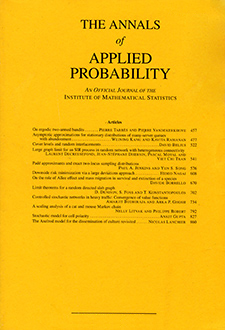Abstract
The following distributed coalescence protocol was introduced by Dahlia Malkhi in 2006 motivated by applications in social networking. Initially there are $n$ agents wishing to coalesce into one cluster via a decentralized stochastic process, where each round is as follows: every cluster flips a fair coin to dictate whether it is to issue or accept requests in this round. Issuing a request amounts to contacting a cluster randomly chosen proportionally to its size. A cluster accepting requests is to select an incoming one uniformly (if there are such) and merge with that cluster. Empirical results by Fernandess and Malkhi suggested the protocol concludes in $O(\log n)$ rounds with high probability, whereas numerical estimates by Oded Schramm, based on an ingenious analytic approximation, suggested that the coalescence time should be super-logarithmic.
Our contribution is a rigorous study of the stochastic coalescence process with two consequences. First, we confirm that the above process indeed requires super-logarithmic time w.h.p., where the inefficient rounds are due to oversized clusters that occasionally develop. Second, we remedy this by showing that a simple modification produces an essentially optimal distributed protocol; if clusters favor their smallest incoming merge request then the process does terminate in $O(\log n)$ rounds w.h.p., and simulations show that the new protocol readily outperforms the original one. Our upper bound hinges on a potential function involving the logarithm of the number of clusters and the cluster-susceptibility, carefully chosen to form a supermartingale. The analysis of the lower bound builds upon the novel approach of Schramm which may find additional applications: rather than seeking a single parameter that controls the system behavior, instead one approximates the system by the Laplace transform of the entire cluster-size distribution.
Citation
Po-Shen Loh. Eyal Lubetzky. "Stochastic coalescence in logarithmic time." Ann. Appl. Probab. 23 (2) 492 - 528, April 2013. https://doi.org/10.1214/11-AAP832
Information





